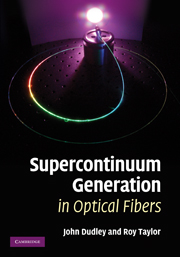Book contents
- Frontmatter
- Contents
- List of contributors
- Preface
- 1 Introduction and history
- 2 Supercontinuum generation in microstructure fibers – a historical note
- 3 Nonlinear fibre optics overview
- 4 Fibre supercontinuum generation overview
- 5 Silica fibres for supercontinuum generation
- 6 Supercontinuum generation and nonlinearity in soft glass fibres
- 7 Increasing the blue-shift of a picosecond pumped supercontinuum
- 8 Continuous wave supercontinuum generation
- 9 Theory of supercontinuum and interaction of solitons with dispersive waves
- 10 Interaction of four-wave mixing and stimulated Raman scattering in optical fibers
- 11 Nonlinear optics in emerging waveguides: revised fundamentals and implications
- 12 Supercontinuum generation in dispersion-varying fibers
- 13 Supercontinuum generation in chalcogenide glass waveguides
- 14 Supercontinuum generation for carrier-envelope phase stabilization of mode-locked lasers
- 15 Biophotonics applications of supercontinuum generation
- 16 Fiber sources of tailored supercontinuum in nonlinear microspectroscopy and imaging
- Index
3 - Nonlinear fibre optics overview
Published online by Cambridge University Press: 06 July 2010
- Frontmatter
- Contents
- List of contributors
- Preface
- 1 Introduction and history
- 2 Supercontinuum generation in microstructure fibers – a historical note
- 3 Nonlinear fibre optics overview
- 4 Fibre supercontinuum generation overview
- 5 Silica fibres for supercontinuum generation
- 6 Supercontinuum generation and nonlinearity in soft glass fibres
- 7 Increasing the blue-shift of a picosecond pumped supercontinuum
- 8 Continuous wave supercontinuum generation
- 9 Theory of supercontinuum and interaction of solitons with dispersive waves
- 10 Interaction of four-wave mixing and stimulated Raman scattering in optical fibers
- 11 Nonlinear optics in emerging waveguides: revised fundamentals and implications
- 12 Supercontinuum generation in dispersion-varying fibers
- 13 Supercontinuum generation in chalcogenide glass waveguides
- 14 Supercontinuum generation for carrier-envelope phase stabilization of mode-locked lasers
- 15 Biophotonics applications of supercontinuum generation
- 16 Fiber sources of tailored supercontinuum in nonlinear microspectroscopy and imaging
- Index
Summary
Introduction
This chapter provides a succinct overview of the various nonlinear effects that can occur when a light field propagates in an optical fibre. Given that nonlinear fibre optics is a very mature research field, it has been covered in much detail by many previous reviews and monographs. The reader is particularly referred to Agrawal (2007) for a treatment that combines a review of both theory and experiments in a way that is simultaneously accessible and technically comprehensive. Other monographs that contain valuable material and references to the original literature include Taylor (2005) and Alfano (2006). In this treatment we provide only a brief introduction to the major concepts, placing particular emphasis on effects that play an important role in supercontinuum generation. Where appropriate, these effects will be discussed in more detail in other chapters. We do, however, treat the numerical modelling of nonlinear pulse propagation in more depth than is usually found in the literature.
Modelling nonlinear pulse propagation
The propagation of an electromagnetic wave or pulse depends on the medium in which it propagates. In vacuum a pulse can propagate unchanged. When propagating in a medium, however, an electromagnetic field interacts with the atoms, which generally means that the pulse experiences loss and dispersion. The latter effect occurs because the different wavelength components of the pulse travel at different velocities due to the wavelength dependence of the refractive index. In an optical waveguide, the total dispersion has an additional component due to the light confinement called waveguide dispersion, which cannot be neglected.
- Type
- Chapter
- Information
- Supercontinuum Generation in Optical Fibers , pp. 32 - 51Publisher: Cambridge University PressPrint publication year: 2010
- 23
- Cited by

